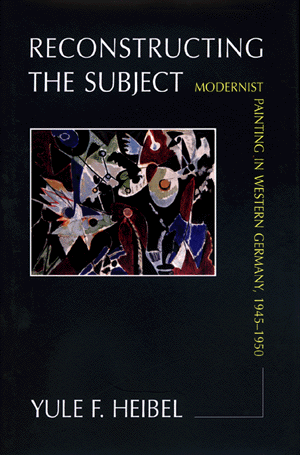On synthesis, simplification, compartmentalization, comfort
Theodor Adorno strongly influenced my approach when I worked on post-World War II German art (specifically, West German abstract art). I was quite surprised recently to be reminded of him while reading Roger Martin’s business book, The Opposable Mind. I mean, Adorno and business? Really?
On p.102-3 of my book, Reconstructing the Subject; Modernist Painting in Western Germany, 1945-1950, I struggle with a critique of synthesis and how it relates to stylistic choices painters made in that place and time. Synthesis was a big deal for many German artists after the war, and in the section I quote here, I started to get into its ideological character:
This talk of synthesis [by Western German artists of the immediate post-World War II period] proved false and disingenuous, however, for consciousness was merely flattering itself by “synthesizing” what it had separated conceptually in the first place. Concepts invariably and unavoidably reproduce the difference between thought and what is thought, but the dream of synthesis – and liberalism is always haunted by it – is an idealism that refuses to analyze this fact.Fear is the driving force behind this drive toward desire for identification and homogenization. Adorno theorized that historically this fear derived from the threat nature represents for unprotected man: the desire to be safe from harm produces an intolerance of that which escapes control, of that which is different and which may threaten. Available social theories prove incapable of coming to terms with the consequences of identification, in part because they also misperceive the radical potential of Romanticism: “Even the theory of alienation,” – a key social theory of the late 19th and 20th centuries – “the ferment of dialectics, confuses the need to approach the heteronomous and thus irrational world – to be ‘at home everywhere,’ as Novalis put it – with the archaic barbarism that the longing subject cannot love what is alien and different, with the craving for incorporation and persecution. If the alien were no longer ostracized, there hardly would be any more alienation.” Thinking, conceptualization, is dual, is split, despite its attempts to claim totality, to ingest “the Other.” Both subject and object are conceptual abstractions.
 A little further down, another Adorno quote: “Consciousness boasts of uniting what it has arbitrarily divided first, into elements – hence the ideological overtone of all talk of synthesis. It serves to cover up an analysis that is concealed from itself and has increasingly become taboo.”
A little further down, another Adorno quote: “Consciousness boasts of uniting what it has arbitrarily divided first, into elements – hence the ideological overtone of all talk of synthesis. It serves to cover up an analysis that is concealed from itself and has increasingly become taboo.”
Martin, on pp.75-77, gets into “Simple Comforts,” which describes our ability to separate things out into neat compartments and accept what he calls the “factory setting” that lulls us into thinking that a given model of reality is the only possible reality.
In every domain, human beings gravitate toward simplification and specialization. We do so, says Stanford management theorist Jim March, because we live in a dauntingly complex and ambiguous world, full of causal inconsistencies. (…) Our reaction to …baffling turn of events is to simplify and specialize. “Organizations,” he says in an article with colleague Daniel Levinthal, “seek to transform confusing, interactive environments into less confusing, less interactive ones by decomposing domains and treating the resulting sub-domains as autonomous.”
That’s the part that called Adorno to mind. What Martin describes struck me as a flip side of the synthesizing drive critiqued by Adorno. The business person breaks the complexity down into component parts, and if his or her mind isn’t particularly creative, s/he continues to see those pieces in isolation, never realizing how they fit together or how they’re capable of leveraging one another into something new. The fantasist-creative type, in turn, might believe that s/he is synthesizing the pieces into a whole – but it might be the old whole.
That is, s/he hasn’t created anything new or innovative, and has instead put something together that the mind (her mind?) separated in the first place. The result is nothing new, just something comforting (and ideological). Does that make any sense? (Remember, this is my blog, and I’m thinking out loud here…)
Could one say that the real trick is in (1) being aware that you are the one who’s pulling the insanely complex whole apart, cherry-picking to begin with what appear to you to be salient pieces (and that you’re doing so for reasons of simplification and personal comfort zones); and (2) avoiding a subsequent simple synthesis (think of gluing Humpty Dumpty back together: boring, that’s just a “fixed,” but still same-old – and cracked – Humpty) by instead putting the pieces “together” in an altogether new way; and (3) acknowledging the artificiality of your construction?
I’m just wondering.
Does our dependancy on technology and computers fit into your equation? It seems to me that the act of pulling the whole apart and “cherry-picking” is increasingly being carried out by artificial intelligence these days.
Also, you mention that we do this for reasons of “simplification and personal comfort zones” what about supply and demand, the bottom line and dare I say greed.
Comment by Elisa — May 2, 2010 #
You observe behaviours:
1. reduce things and synthesize them back together
2. reduce things and keep them in parts
And imply that although #1 may be better than number #2, it is still inferior to a theoretical third behaviour:
3. keep things together
But do we have any reason to believe that humans are capable of this? I think Kant would say not. So shouldn’t the synthesizers be smug for being the least worst?
Comment by Jared — May 2, 2010 #